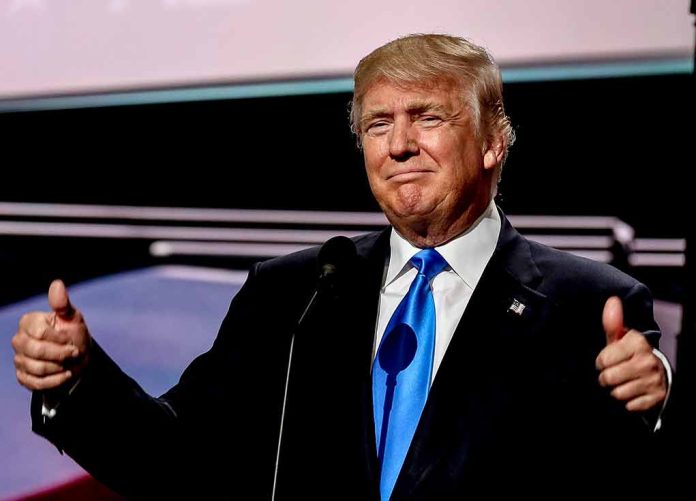
President Trump’s bold economic vision is finally paying off as major corporations pour billions into American manufacturing, proving his critics wrong with each new factory groundbreaking across the nation.
At a Glance
- TSMC is investing $100 billion in advanced semiconductor manufacturing, creating tens of thousands of high-paying American jobs
- Eli Lilly plans to establish four new manufacturing sites in the U.S., more than doubling its investment to $50 billion
- President Trump’s tariffs and manufacturing policies are driving a historic shift away from decades of globalist free trade
- GE Aerospace, Apple, Hyundai, and NVIDIA have all announced major U.S. manufacturing expansions
- The Trump administration is implementing tax incentives and appointing a “manufacturing ambassador” to attract more companies
Trump’s Manufacturing Renaissance Takes Shape
The promise President Trump made to bring manufacturing back to America is becoming reality as major corporations across multiple sectors announce massive investments in domestic production. After years of watching American factories close and jobs disappear overseas, the tide is finally turning. Trump’s implementation of strategic tariffs and business-friendly policies is creating what economists are calling a fundamental realignment of the U.S. industrial base, with companies rushing to establish or expand their American manufacturing footprint rather than face increasing penalties for foreign production.
President Trump’s economic strategy marks what many experts describe as the most significant shift in U.S. trade policy in generations. “Jobs and factories will come roaring back,” said President Trump. His administration’s focus on reviving American manufacturing represents “a tectonic shift in U.S. economic policy, the fullest repudiation of an embrace of global free trade that began on a bipartisan basis in the 1980s.”
Tech Giants Lead the Charge in Domestic Production
Taiwan Semiconductor Manufacturing Company (TSMC) is leading the technology sector’s return to American soil with a staggering $100 billion investment in advanced chip manufacturing facilities. The company’s Arizona campus will create thousands of high-tech jobs and help secure America’s technological independence from foreign suppliers. This massive investment comes as the semiconductor industry recognizes the strategic importance of having production capabilities within U.S. borders, especially as global supply chains have proven vulnerable to disruption.
In the rapidly evolving artificial intelligence sector, NVIDIA is partnering with various companies to design and build factories for AI supercomputers entirely within the United States. The company has already commissioned over 1 million square feet of manufacturing space for this purpose. These facilities will ensure America remains at the forefront of the AI revolution while creating high-skilled jobs that can’t be easily outsourced. Apple has similarly pledged $500 billion over four years to invest in American innovation and advanced high-skilled manufacturing.
Healthcare and Automotive Sectors Make Historic Investments
The pharmaceutical industry is also answering President Trump’s call to bring manufacturing back home. Eli Lilly plans to establish four new manufacturing sites across the United States, more than doubling its U.S. manufacturing investment to $50 billion. This expansion will create thousands of jobs while ensuring critical medications are produced domestically rather than relying on foreign suppliers. The move comes as the healthcare industry recognizes the national security implications of having vital medical production capabilities based overseas.
Today’s announcement—a $3B manufacturing expansion in Kenosha County, Wisconsin—is our largest U.S. manufacturing investment outside of Indiana. This will help meet the growing demand for our diabetes, obesity and other future medicines. https://t.co/VQmGCmriDy #WeAreLilly pic.twitter.com/lYLppO4UPB
— Eli Lilly and Company (@EliLillyandCo) December 5, 2024
In the transportation sector, Hyundai Motor Group has announced plans for a $21 billion investment in the United States. The Korean automaker is focusing on increasing production, parts localization, and future industries within American borders. This investment represents one of the largest commitments by a foreign automaker to U.S. manufacturing in recent history. Meanwhile, GE Aerospace is investing nearly $1 billion into its U.S. manufacturing and supply chain operations, with plans to hire approximately 5,000 American workers.
Trump’s Four-Pillar Strategy for Manufacturing Dominance
The Trump administration’s approach to revitalizing American manufacturing rests on four main pillars: reducing the corporate tax rate, expanding R&D tax credits, re-instituting 100% bonus depreciation, and expanding spending for new manufacturing investments. These policies create powerful financial incentives for companies to build and expand within the United States rather than overseas. Additionally, the President plans to appoint a “manufacturing ambassador” specifically tasked with attracting international companies to establish production facilities on American soil.
President Trump is also leveraging the Defense Production Act (DPA) to accelerate domestic production in key sectors critical to national security. This approach recognizes that certain manufacturing capabilities are too important to be outsourced to potential adversaries. By utilizing these executive powers, the administration can ensure America maintains industrial capabilities essential for both economic prosperity and national defense. The strategy includes proposed legislation to lower tax rates specifically for companies that refrain from outsourcing or offshoring their operations.
With each new manufacturing announcement, it becomes increasingly clear that President Trump’s economic vision is bearing fruit. After decades of industrial decline that hollowed out American communities, the nation is witnessing the beginning of what may become the greatest manufacturing renaissance in generations. As factories rise and help-wanted signs appear, the economic transformation Trump promised is becoming tangible reality for millions of American workers.






















